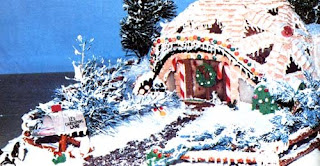Math Gets Around: Holiday Treats
At this time of year, many people push their studies to the side in favor of roasted animals and pie. However, the activities of enlarging your waistline and mastering some mathematics need not be mutually exclusive. For evidence of this claim, I need only turn your attention to the culmination of thousands of years of human evolution: the Pecan Pie-cosahedron.
This masterful work of craftsmanship was created by an individual known by the pseudonym of turkey tek over at instructables.com. The pie is so named because it has the shape of an icosahedron, arguably the most beautiful of the five1 Platonic Solids (so named because of the Greek philosopher, not because the solids are just good friends). Even better, this isn't turkey tek's first foray into mathematically inspired baked goods: also on display is the formiddable Giant Fractal Pecan Pie.
Such seminal work naturally gives rise to the question: In what other ways can one combine holiday sweets with mathematics? After some careful deliberation, I humbly submit the following ideas.
1) Gingerbread Geodesic Domes.
The gingerbread man leads a tragic life. His sole purpose is to be put on display in the hope that he will be purchased and devoured. Often his life is ended through the horrifying mutilation of his appendages, all in the name of holiday cheer.
It seems reasonable, then, to let the gingerbread man get the most out of his short and sweet existence by accomodating him with a relatively luxurious lifestyle. This is the primary role of the gingerbread house.
While there are many people who pride themselves in their ability to make a fantastic and functional gingerbread house, it is a sad fact that these days, with people looking for quick solutions, boxed gingerbread houses are becoming more and more common. The pieces of the house are all included - all that's left for the builder is to attach them, so that the process becomes akin to building an edible lego set. Unfortunately, this leads to a certain degree of uniformity in gingerbread dwellings, not to mention questionable quality of the building materials itself.
The least we can do for our small edible acquaintances, it seems to me, is to have enough respect for them that we take the time to build them a unique home, made from fresh gingerbread. With this goal in mind, I believe the gingerbread geodesic dome would be greatly appreciated by gingerbread man and woman alike. Not only would it provide them with a comfortable place to spend their limited time on this earth, but it's also useful should you wish to provide your gingerbread populace with facilities such as planetariums.
For those interested in learning more about gingerbread geodesic domes, here is an article from Mother Earth News that should provide you with enough information to get started.
2) Sugar Cookie Math Ornaments.
Apparently, in some families it is tradition to decorate the Christmas tree with edible ornaments. The ornaments are made from thin sugar cookies, which are often cut into holiday themed shapes.
However, I see no reason why the holiday motif should be allowed to overshadow equally important themes. Mathematics is always in season, so why not make some cookies that will allow your children to express themselves through mathematics? Let your children decorate the tree with their favorite equality, or let them turn the tree into a center for edible math problems, by allowing them to use the ornaments to pose questions they can then solve! With sugar cookie math ornaments, you can exploit the natural harmony that exists between math and the holidays.
Surprisingly, there's not much in the way of math inspired cookie cutters, so you may have to do some custom work. You can find some number shaped cookie cutters, and it's not hard to find Roman alphabet cutters as well. Greek letters, unfortunately, remain elusive.

3) The Dreidel.
This one is easy - the game of dreidel, as with other games of chance, naturally lends itself to many discussions of mathematics. In fact, there are even theorems in math that pertain to dreidels. For example, in 2004, mathematicians Thomas Robinson and Sujith Vijay from Rutgers University proved that the length of a game of dreidel is bounded by a constant times n2 spins, where n is the number of tokens at play in the game.
If you're looking for a holiday game that incorporates mathematics, you certainly can't go wrong with a friendly game of dreidel.
You see, no matter what your plans for the holidays, it's easy to incorporate mathematics in with your celebrations. Everyone knows that a party can only be made more lively with the inclusion of some math, so whether it's one of these ideas, or one of your own, don't be shy about putting giving math an important role this season.
1. For those of you who find it curious that there are only 5 Platonice solids (the tetrahedron, cube, octahedron, dodecahedron, and icosahedron), here is one elementary proof of this fact.
Psst ... did you know I have a brand new website full of interactive stories? You can check it out here!
comments powered by Disqus



